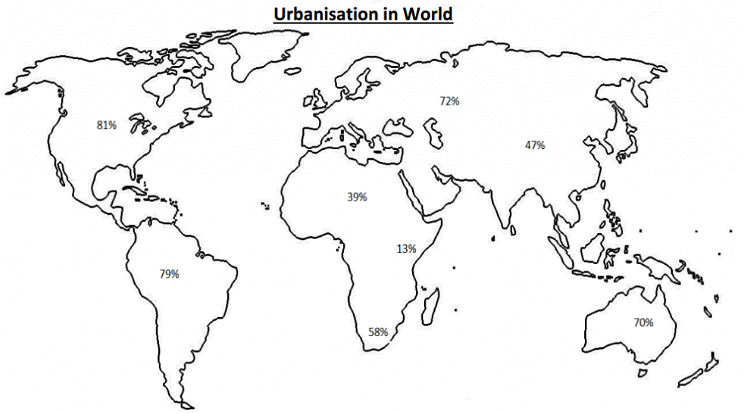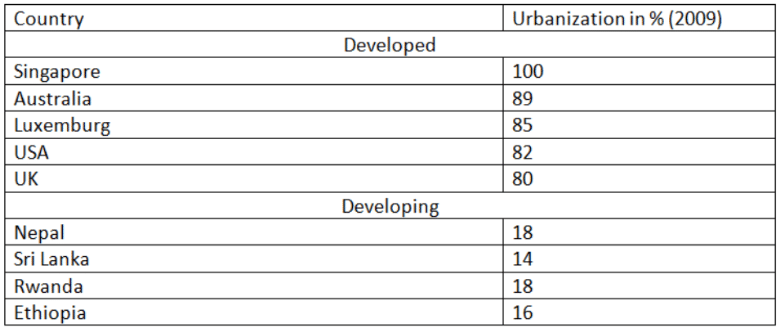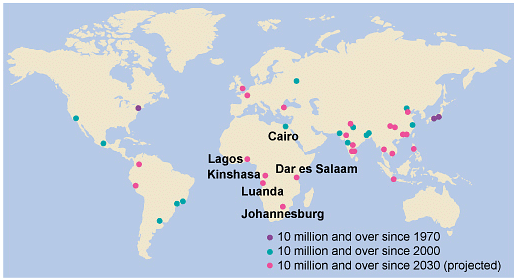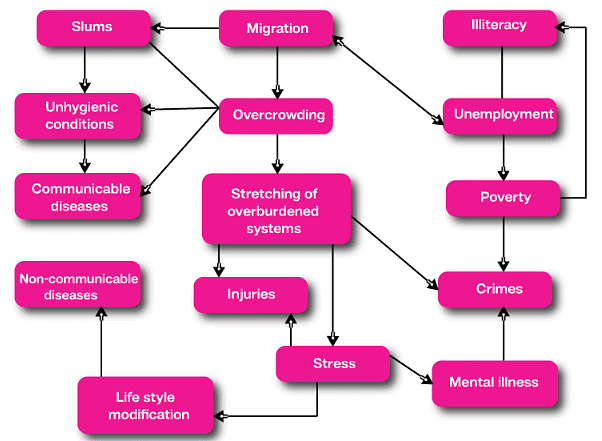UPSC Exam > UPSC Notes > Indian Society for UPSC CSE > Urbanisation – Problems & Remedies
Urbanisation – Problems & Remedies | Indian Society for UPSC CSE PDF Download
Introduction
- In general usage, urbanization refers to the relative concentration of a territory’s population in towns and cities (i.e. relative urban growth). It may also refer to the process of being urban.
- As a demographic process, which is the commonest use of the term, urbanization involves towns and cities growing in relative size within a space economy through, first, an increasing proportion of the population living in an urban place and, second, their concentration in the target urban settlement. The end of the sequence is an almost completely urbanized society, with the great majority of the population living in just a few larger places.
- Linked to these demographic processes (with migration the main contributor to urban growth) are the structural changes in the society consequent upon the development of capitalism (i.e. structural urbanization). Cities are the foci of production, distribution, and exchange process, because of the economies of scale and scope from agglomeration. Urbanization is the necessary component of industrialization and development (though seen over urbanization)
- Finally, there is behavioral urbanization. Urban areas especially the larger ones are centers of social change. Values, attitudes, and behavior patterns are modified in the urban milieu (known as urbanism) and new forms (which may be reflected in townscape as with architectural styles) then spread through the urban system through diffusion processes.

- This three-part model of urbanization has demographic change as a dependent variable within a process driven by structural imperatives. As a model, it is particularly suited to the analysis of modern capitalism. It has been demonstrated for example, that substantial urban growth and urbanization occurred in other parts of the world, notably Asia long before the industrial revolution and rapid urbanization in the North Atlantic area in the nineteenth and twentieth century.
- City growth is not the feature of industrial societies alone and large settlements have characterized other forms of economic integration; similarly, rapid urban growth is occurring in many parts of the Third World as migrants flock to cities with aspirations for both better economic and social conditions than found in smaller places. Thus, as the arguments over counter urbanization also shows demographic urbanization can occur in a variety of contexts, and what is typical of one time and place may not be typical of others.
Urbanization Definition
- Any places having municipality, corporation, cantonment board, or notified town area committee. All the other places which satisfy the following criteria :
- A minimum population of 5000 persons ;
- At least 75 % of male main working population engaged in non-agricultural pursuits ; and
- A density of population of at least 400 persons per square kilometer.
Spatial pattern of urbanisation
Percentage Urban and Rate of Urbanization of the World, by Development Group, Selected Years and Periods, 1950-2050



- Developed countries are characterised by high level of urbanisation, while the developing countries have low level of urbanisation. But the urban growth rate of developing countries is very high, in spite of very high urban annual growth rate; many developing countries have low level of urbanisation.
- This shows the sharp difference of urbanisation between the developed and developing countries.
- Global urban population is growing at rapid rate from 17% in 1951 to 20% in 2001 and expected to increase 41% in 2020.



Major causes of urbanization
- Industrial revolution: Industrial employment catches the attention of people from rural to urban areas. In the urban areas, people work in modern sector in the occupations that assist national economic development. This represents that the old agricultural economics is changing to a new non-agricultural economy. This is the trend, which will build a new modern society (Gugler 1997).
- Emergence of large manufacturing centres.
- Job opportunities: There are ample job opportunities in mega cities therefore village people or individuals from town frequently migrate to these areas.
- Availability of transportation: Due to easy transport, people prefer to stay in big cities.
- Migration: Migration is main cause for rapid growth of mega-cities. Migration has been going on over centuries and it is normal phenomenon. When considering urbanization rural-urban and urban-rural and rural-rural migrations are very important. Urban-urban migration means that people move from one city to another. People may move to the city because they are forced by poverty from rural community or they may be pulled by the magnetism of city lives. Combination of these push and pull factors can force people to migrate to cities (Gugler 1997).
- Infrastructure facilities in the urban areas: Infrastructure has vital role in the process of urbanization in the development of countries. As agriculture becomes more fruitful, cities grow by absorbing workforce from rural areas. Industry and services increase and generate higher value-added jobs, and this led to economic growth. The geographic concentration of productive activities in cities creates agglomeration economies, which further raises productivity and growth. The augments income and demand for agricultural products in cities.
- Growth of private sector.
Problems in developed countries
- Urban to rural migration (or urban sprawl): as the urban area is expanding, urban culture is spreading. This leads to:
- Decline in agricultural land: In UK, more than 15% of fertile agricultural land is under built-up area. West Europe is facing a food shortage.
- It is reducing rural-urban dichotomy and bringing about the rural-urban continuum. This continuum in the long run is going to harm the agricultural economy.
- Transportation cost increases.
- Urban pollutants are reaching in villages.
- Municipal revenue is declining.
- Problem of vacant houses.
- Environmental degradation: Industrial complexes remain in towns. Skyscraper winds and many other patterns of wind have emerged. Acid rain, temperature increase, air pollution, etc. are of concern. This leads to health problems.
- Demographic problems: inverse age pyramid is an outcome. Old-age occupants dominate the town. This is called neo population explosion. The impact is labour shortage. As a result:
- Most of the developed countries have liberalized their immigration laws. E.g.- Australia earlier had a White Australian policy, under which only whites can settle in Australia. But, later in 1975, this policy was ended.
- Family system is breaking- nuclear families are emerging. The European system is facing social disorder.
Problems in developing countries
- Population explosion: of the large-sized urban centers, particularly the metropolitan cities and capital cities. This is due to both rural-urban and urban-rural migration. Capital cities attract due to both social and political reasons. Also, capital centres attract many industrial complexes due to better infrastructure and market
- Environmental degradation: it includes problems such as:
- Slum growth
- Housing shortage
- Inadequate Public Utility Services
- Urban poverty
- Pollution
- Unplanned land use
- Transport problems: the insufficient transport infrastructure leads to capacity overloading, causing problems such as road accidents, traffic jams, etc. E.g. as per World Disaster Report, per 10000 licensed vehicle, there has been a maximum number of fatal accidents in Ethiopia (needs update)
- Outer expansion of towns: there is no planned urban sprawl, the rapid growth of RUF, and unplanned settlement outside the town.
- Urbanization is not at all problems, but unsustainable and unplanned urbanization creates the following problems:
- Urban Sprawl
- Congestion
- Shortage of houses
- Vertical expansion
- Growth of slums and substandard houses
- Illegal settlements


Some additional topics
- Counter Urbanisation: Counter urbanization is when large numbers of people move from urban areas into the surrounding countryside or rural areas. It is both a demographic (population-driven) and social process but has to a lesser extent also involved the movement of some businesses and economic activities.
- Over urbanization: it refers to population growth in an urban area which outstrips its job market and the capacity of its infrastructure; ‘urbanization without industrialization.
- Urbanism: it refers to the way of life associated with the residents of the urban areas. Urbanization is the movement of people from rural to urban areas, and the result is the growth of cities. It is also a process by which rural areas are transformed into urban areas. Urbanization is a process that has occurred or is occurring, in nearly every part of the world that humans have inhabited. People move into cities to seek economic opportunities.
- Rural-urban continuum: it refers to a continuous gradation of a way of life between two poles of truly rural community and truly urban society. Proponents of the continuum theory feel that rural-urban differences occur in a relative degree in a range extending between two polar extremes of rural and urban. The continuum theory lays emphasis on the rural-urban differences rather than on the rural-urban dichotomy. Irrespective of the course of evolution, the distinction can be drawn between the rural and urban ways of life.
- Stages in urbanization: In many developed countries the process of urbanization is almost at an end and the proportion of urban dwellers is beginning to fall. The progress has followed the S-shaped curve and it seems to have tilted off at 80% of the total population. There are 5 stages:
- Very slow growth with most people employed in agriculture.
- Rapid urbanization associated with economic development
- Urbanisation ends – the vast majority lives in towns and cities and are employed in industry and services
- Counter urbanization occurs and the urban proportion decreases as same prefer to commute.
- Re urbanization associated with the revival of urbanization.
Remedies for Urbanization
- Urban centers of developing countries first need to check the rural-urban migration. It needs rural development and the development of smaller town areas. The legal framework for town planning should be strictly enforced for better land use. Slum recreation, poverty eradication, house construction is to be done. Global help for capital and technology is needed for housing and job creation. It needs a multidimensional approach.
- Rapid Mass Transport (RMT) for better transportation system.
- Reform of the urban water sector.
- Efficient use of urban land – Scientific town planning & Sustainable development of urban planning needed.
- Long term strategic urban planning with the overall regional planning perspective.
- The environmental sustainability of urban development.
- Investment in new urban infrastructure assets and maintenance of assets.
- Need to strengthen urban governance
- To strengthen the ‘soft infrastructure’
- Improvements of urban utilities such as water and sewerage NUHM (National Urban Health Mission) for better urban public health.
- Need to fulfill the basic needs of the urban poor.
- Migration needs to be regulated
- Smart city concept if implemented effectively
- Provision of Urban Amenities to Rural Areas (PURA)
- Population control
- Innovation needed to control pollution and waste handling
- Rurbanization: Provide like urban facilities in rural areas or make rural areas smart is called rurbanization.
The document Urbanisation – Problems & Remedies | Indian Society for UPSC CSE is a part of the UPSC Course Indian Society for UPSC CSE.
All you need of UPSC at this link: UPSC
|
21 videos|125 docs
|
FAQs on Urbanisation – Problems & Remedies - Indian Society for UPSC CSE
| 1. What is urbanisation and what are some of its problems? |  |
Ans. Urbanisation refers to the process of an increasing population shifting from rural areas to urban areas, resulting in the growth and expansion of cities. Some of the problems associated with urbanisation include overcrowding, inadequate housing, increased pollution, traffic congestion, strain on infrastructure, and the loss of agricultural land.
| 2. How does urbanisation contribute to environmental pollution? |  |
Ans. Urbanisation contributes to environmental pollution in several ways. As cities grow, there is an increase in industrial activities, transportation, and energy consumption, leading to higher levels of air and water pollution. The concentration of vehicles in urban areas also leads to increased emissions of greenhouse gases, contributing to climate change. Additionally, urbanisation often leads to the destruction of natural habitats and loss of biodiversity.
| 3. What are the consequences of inadequate housing in urban areas? |  |
Ans. Inadequate housing in urban areas has several consequences. Firstly, it leads to the growth of slums and informal settlements, where people live in substandard conditions with limited access to basic amenities like clean water and sanitation. This can result in health issues and the spread of diseases. Inadequate housing also leads to overcrowding, which further strains the existing infrastructure and services in urban areas.
| 4. How does urbanisation affect the availability of agricultural land? |  |
Ans. Urbanisation often leads to the conversion of agricultural land into residential, commercial, or industrial areas, resulting in a decline in the availability of agricultural land. This can have significant implications for food security, as the loss of fertile land reduces the capacity for agricultural production. It also disrupts the livelihoods of farmers who depend on agriculture for their income.
| 5. What are some potential remedies to address the problems caused by urbanisation? |  |
Ans. There are several potential remedies to address the problems caused by urbanisation. These include:
- Implementing effective urban planning strategies to ensure sustainable development and efficient use of resources.
- Investing in the development of affordable housing and improving the living conditions in slums and informal settlements.
- Promoting public transportation systems and encouraging the use of non-motorized modes of transport to reduce traffic congestion and air pollution.
- Implementing measures to protect and preserve green spaces and biodiversity in urban areas.
- Promoting decentralized urban development to reduce the pressure on major cities and distribute economic opportunities more evenly.
Related Searches





















